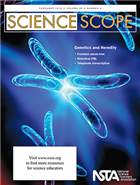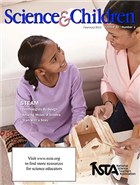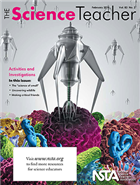First Look: Hands on with the Pasco Wireless Temperature Sensor
By Martin Horejsi
Posted on 2016-02-21
The humble electronic thermometer is often the gateway technology into the world of digital data collection, and Pasco Scientific just made that tech much more affordable. And Bluetooth to boot! Whether measuring thermal motion at -40 degrees C which happens to be about the freezing point of Mercury, to 125 degrees C which happens to be the melting point of Iodine, the Pasco Wireless Temperature Sensor will do the job.


Using a stainless steel probe of 12cm in length and 5mm in diameter is topped with a boxy gasket-sealed plastic housing, the device is simple to use, familiar in design, and both large enough and small enough for most classroom activities.

What separates this particular probe from others on the market, and also a likely factor explaining its low price, is that the Pasco Wireless Temperature Sensor 1) uses a user-replacable CR2032 coin battery, 2) contains no on-board display with two indicator LEDs (one for on/off status and one for Bluetooth) providing all visible probe-side activity. And compared to other sensors in this form factor, there is no mistaking the blinking lights as they are quite conspicuous which is a good thing. And 3) the Pasco Wireless Temperature Sensor is just a radio transmitter beeping a short-range data point as often as 10 times a second. The technology for measuring temperature and popping off a radio blip is well dialed-in so the cost of materials to build a sensor such has this has come down drastically in the past few years. So all the heavy lifting (data visualization and manipulation) is done by the competing device that the Pasco Wireless Temperature Sensor is talking to.
Here’s the instruction manual for the sensor.

An note about the batteries: The three volt CR2032 cell that the Pasco Wireless Temperature Sensor uses is a very common size that can be purchased in most grocery stores. However, the cost of one battery might be the same as a half-dozen or more batteries when purchased in bulk. Pasco sells the batteries for a buck a piece when you by 10. When I wander the digital isles of Amazon.com and often can find name-brand coin cells for around that price as well.

The Internet of Things (IoT)
https://en.wikipedia.org/wiki/Internet_of_Things
The year 2013 was a big deal for IoT in that a perfect storm of technology intersected allowing us to vastly improve and increase our wired and wirelessly connected electronics. A leader in the IoT revolution was Bluetooth. Not the medieval 10th century king, but the wireless technology standard. And today the Pasco Wireless Temperature Sensor uses Version 4.0 Bluetooth also known as Low Energy Bluetooth, or BLE, or Bluetooth Smart. We are actually up to Bluetooth 4.2 as of this writing, but the security and extended packet lengths are not needed with temperature sensors.

A student, an 8th grade science aficionado to be more specific, took the Pasco Wireless Temperature Sensor for a spin on the river. Normally the weather would have the numbers in the single digits or even the thermodynamically absurd negative numbers, to this day was more like April or May than February in Montana.
Although the Pasco Wireless Temperature Sensor should survive brief total submersion in water due to it’s O-ring seals, only the metal probe should be immersed in the fluid to be measured. For this reason, I lightly sealed the probe’s head in a small zip-closure bag which also provided an attachment point to which a length of cord could connect the probe to the user.

After pairing the Pasco Wireless Temperature Sensor with an iPad Mini on shore, the student began moving away from dry land to test the range of the sensor. After a few repeated measurements, the Mini lost contact at about 33 meters, line of sight. I look forward to testing the distance with larger appliances including the iPad Pro.

The simplicity and intuitiveness of the Pasco Wireless Temperature Sensor makes using it, even for the first time, simple. Once on, the latest version of the SparkVue app is opened on almost any current device, and the Bluetooth button pushed. The Pasco Wireless Temperature Sensor pops up as a choice. Once selected, SparkVue is operated like it normally is with hardwired sensors.

At the end of the day on a Montana river in February, the sun was setting, the temperature dropping, and the margin of error between science fun and stupid was getting smaller.
In the end, this first adventure with the Pasco Wireless Temperature Sensor turned out well. The sensor preformed as advertised, and the temperatures were interesting and investigative, not life threatening which is always a good thing.
[youtube]https://youtu.be/ABGtDJLDrSI[/youtube]
The humble electronic thermometer is often the gateway technology into the world of digital data collection, and Pasco Scientific just made that tech much more affordable. And Bluetooth to boot!
Ideas and information from NSTA's February K-12 journals
By Mary Bigelow
Posted on 2016-02-21
This month, all three journals include Planning NGSS-Based Instruction: Where Do You Start? This article is another must-read for teachers who are looking for ideas to incorporate student questions and interests with the Next Generation Science Standards.
The lessons in all three journals include detailed graphic organizers showing how the authors would align the lesson to the NGSS. And if you’re interested in writing for an NSTA publication, the TST editor has some suggestions and encouragement!
A great benefit of NSTA is that members can access all of the journals online. So check out ideas that can be adapted for your students, regardless of grade level.

Science Scope – Genetics and Heredity
This month’s featured articles have ideas for incorporating crosscutting concepts and science practices with the content in genetics units.
- Using Local Street Trees to Teach the Concept of Common Ancestry has a lesson (available online) that goes beyond simply identifying trees to studying evolutionary relationships among species.
- From Mendel to Me: Constructing Genetics Knowledge Through Historical Problem-Based Learning provides a different context for traditional topics such as Punnett squares and
- Pass the DNA, Please uses a variation of the “telephone” game to simulate the idea of genetic transcription and translation and mutations.
- Controversial Environmental Issues Explored Through Interdisciplinary Perspectives: The Case of the Bald Eagle, the Botanical Garden, and the Airport has a real-life context for examining the relationships (sometimes controversial) between human needs and wildlife habitats.
- This month’s Guest Editorial Epigenetics: A New Science for Middle School—And Why You Should Teach It has a good overview of this growing field of science, along with resources for learning more about it yourself.
For more on the content that provides a context for these projects and strategies see the SciLinks websites Biodiversity, Differentiation, DNA, Genetic Traits, Genetics, Genotypes, Identifying Trees, Leaf Structure and Function, Mendel’s Laws, Mendelian Genetics, Mutations, Punnett Squares.
Continue for Science and Children and The Science Teacher.
 Science and Children – STEAM
Science and Children – STEAM
“Brainstorming solutions and creating scientific investigations can be enhanced through an innovative, creative, artistic approach.” (S&C editor).
- Mars Colony integrates role-playing into a simulated exploration of the planet (photographs included).
- Amazing Muses of Science shares the experience of students writing and performing a play that highlights contributions of women scientists.
- Kindergarten students, Ornithologists By Design, design, construct, and evaluate bird feeders in their own school-based “sanctuary.”
- Based on a book they read in class. Start With a Story has the story of students working with a zoo on interdisciplinary activities, such as designing animal habitats.
- In Luminous Lighting, students went beyond constructing simple circuits and applied what they know to creating wire sculptures that light up.
- Teaching Through Trade Books: The Science of Art has two 5E lessons in which students explore the science of crayons and how balloons such as those in parades are designed and engineered. For more on color, see Science 101: What’s Going on When You Mix Colors?
- The Early Years: Fostering Environmental Stewardship illustrates how students can communicate what they learn about nature through making and displaying collages. Methods and Strategies: Using Acorns to Generate an Entire Alphabet has ideas for enhancing language development through teachable moments during outdoor activities.
- Safety First: Safety Picks Up “STEAM” is another must-read article for elementary teachers to pro-actively design safe learning activities.
- Engineering Encounters: What Makes a Superhero “Super”? explores the concept of gravity.
For more on the content that provides a context for these projects and strategies see the SciLinks websites Birds, Colors, Current Electricity, Forces and Motion, Gases, Gravity, Matter, Habitats, States of Matter, Physical Properties of Matter, Planets, Space Exploration.
 The Science Teacher – Activities and Investigations
The Science Teacher – Activities and Investigations
The featured articles have lots of ideas and resources for NGSS-aligned investigations in the life and physical sciences.
- Uncovering Wildlife includes a 5E lesson for turning the school grounds into an authentic research center using “cover boards” (photos included) to collect data on species that live there.
- Making Critical Friends describes a process for guiding pairs of students through the process of scientific argumentation around socioscientific issues such as energy sources, climate change, or GMOs.
- Shedding Light on the “Science of Small” has a 5E lesson in which students investigate titanium oxide nanoparticles as catalysts activated by UV radiation. The detailed article also includes photographs.
- A Virtuous Cycle introduces the Formative Assessment Design Cycle, a collaborative plan for designing common assessments. The cycle is illustrated in the context of a lesson in natural selection and the development of birds’ beaks.
- Finding Patterns describes an alternative to lectures and memorization for learning about how compounds are named, guiding students through pattern identification.
- Science 2.0: Mastering Scientific Practices With Technology recommends technology tools that support the NGSS science and engineering practices of Asking Questions and Defining Problems, Developing and Using Models, and Planning and Carrying Out Investigations.
- The Green Room: Conserving Tropical Rain Forests suggests resources for looking at conservation efforts and preserving biodiversity in these environments.
- Health Wise: Getting Past the Peak of Flu Season lists topics students could investigate related to the spread of diseases.
For more on the content that provides a context for these projects and strategies see the SciLinks websites Biodiversity, Bird Adaptations, Characteristics of Birds, Genetically Modified Crops, Habitat, Infectious Diseases, Naming Compounds, Nanotechnology, Rain Forests, Vaccinations, Viruses.
This month, all three journals include Planning NGSS-Based Instruction: Where Do You Start? This article is another must-read for teachers who are looking for ideas to incorporate student questions and interests with the Next Generation Science Standards.

